
Rich diversity of crops from 14 genebanks recently secured in Svalbard Global Seed Vault
Peanut, carrot, pigeon pea, rice and rye. This small selection represents a long list of crops that were brought into the Seed Vault in early June. Svalbard Global Seed Vault is know to function as a security storage facility for the world's valuable genebank collections – but it's also the site of an seed viabilty experiment that will last for 100 years.
In early June in Svalbard, the temperature is around zero degrees Celsius and the midnight sun keeps the dark hours of the day at a safe distance. It is now time to open the gates to Svalbard Global Seed Vault for the second seed deposit of the year. This week's deposit includes around 11,000 seed samples from 14 genebanks for safekeeping in the Seed Vault's ice-cold chambers (see the facts below for a list of the participating genebanks).
”Each genebank collection is unique and their seed samples carry traits that can contribute to the development of future crops and significantly impact our food security. Therefore, it is encouraging to see these boxes from several continents brought into the cold safety of Svalbard Global Seed Vault,” says Lene Krøl Andersen, NordGen’s Executive Director.

As usual, a rich diversity of crops is included in the deposit, but cereals and various types of vegetables and legumes dominate among the genebanks' long lists of contents. In total, some 30 boxes were placed on the shelves deep down in the mountain Platåberget by NordGen staff.
Seed samples in place for the 100-year experiment
In addition to this, NordGen staff also worked on organizing all the boxes that are part of the 100-year experiment – an initiative that aims to investigate the viability of different seeds when stored under optimal conditions for 100 years. The experiment involves 14 globally important crops from six genebanks and all seed samples are now in place in the Seed Vault. In addition to NordGen, the genebanks included are NRSSL (Thailand), ICRISAT (India), INIAV (Portugal), IPK (Germany) and Embrapa (Brazil).
It is already known that if seeds are of good quality and handled correctly, they can survive for a long time under the right conditions, sometimes several centuries. But there are also large differences in the lifespan between different plant species and precise information over such a long period of time is lacking for obvious reasons. NordGen is responsible for ensuring that the seed samples in the experiment are optimally prepared for long-term storage (drying and packaging) and the Kimen Seed Testing Laboratory in Ås, Norway, will conduct germination tests every ten years.
”For genebanks to make better decisions about the long-term management of their seed collections, more and better data is needed. This experiment will provide valuable information for the next 100 years and increase the overall knowledge of seed longevity," says Åsmund Asdal, NordGen's Seed Vault Coordinator.

Two 100-year experiments?
- In addition to the experiment in the Seed Vault, a 100-year experiment is ongoing in Coal Mine 3 in Svalbard, which was initiated already in 1984.
- The experiment in the coal mine focuses on how seeds of Nordic plant species survive in permafrost compared to –18°C in the Seed Vault.
- Here you can read a report about the coal mine experiment after 35 years.
Seed deposit June 2025
Participants – Country
- Austrian Agency for Health and Food Safety (AGES) – Austria
- Laboratory of Genetics, Biotechnology and Seed Sciences – Benin
- Genetic Resources Institute, KALRO – Kenya
- ICARDA – Lebanon
- Center for Genetic Resources (CGN, WUR) – The Netherlands
- National Plant Genetic Resources Laboratory – The Philippines
- Plant Breeding and Acclimatization Institute – Poland
- National Agricultural and Food Centre – Slovakia
- National Agrobiodiversity Center, RDA – South Korea
- Sveaskog – Sweden
- Warwick Genetic Resources Unit – Great Britain
- Seed Savers Exchange – USA
- Can Tho University – Vietnam
- SADC Plant Genetic Resources Centre – Zambia
Svalbard Global Seed Vault
- The Svalbard Global Seed Vault is the world's largest security facility for the diversity of crops preserved in the world's gene banks.
- The building is owned by Norway and operated by three partners; the Norwegian Ministry of Agriculture and Food, the international organization Crop Trust and NordGen.